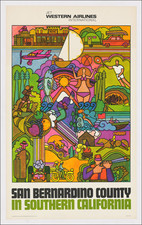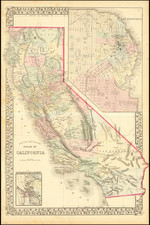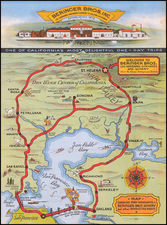Rare chart of the Coast of California from Venegas' Noticia de la California, published in Madrid in 1757.
The chart shows the coast of California from the Farallone Islands and Point Reyes with a large unnamed bay (San Francisco Bay?).
The map extends south to Cabo San Lucas and the entry to the Gulf of California, along with the Mexican Coastline, to just south of Acapulco. The map illustrates the relevant coastal features of the Manila Galleon Trade.
The Manilla Galleons were Spanish trading ships that made round-trip sailing voyages once or twice per year across the Pacific Ocean from the port of Acapulco in New Spain (present-day Mexico) to Manila in the Spanish East Indies, now the Philippines. The name of the galleon changed reflecting the city that the ship was sailing from. The term Manila Galleons is also used to refer to the trade route between Acapulco and Manila, which lasted from 1565 to 1815.
The Manila Galleons were also known in New Spain as "La Nao de la China" (The China Ship) because it carried largely Chinese goods, shipped from Manila.
The Manila Galleon trade route was inaugurated in 1565 after Augustinian friar and navigator Andrés de Urdaneta discovered the tornaviaje or return route from the Philippines to Mexico. The first successful round trips were made by Urdaneta and by Alonso de Arellano that year. The route lasted until 1815 when the Mexican War of Independence ended Spanish control of Mexican ports. The Manila galleons sailed the Pacific for 250 years, bringing to Spain their cargoes of luxury goods, economic benefits, and cultural exchange.
In 1521, a Spanish expedition led by Ferdinand Magellan sailed west across the Pacific using the westward trade winds. The expedition discovered the Mariana Islands and the Philippines and claimed them for Spain. Although Magellan died there, one of his ships made it back to Spain by continuing westward.
In order to settle and trade with these islands from the Americas, an eastward maritime return path was necessary. The first ship to try this a few years later failed. In 1529, Álvaro de Saavedra Cerón also tried sailing east from the Philippines, but could not find the eastward winds across the Pacific. In 1543, Bernardo de la Torre also failed. In 1542, however, Juan Rodríguez Cabrillo helped pave the way by sailing north from Mexico to explore the Pacific coast, reaching as far north as the Russian River, just north of the 38th parallel.
The Manila-Acapulco galleon trade finally began when Spanish navigators Alonso de Arellano and Andrés de Urdaneta discovered the eastward return route in 1565. Sailing as part of the expedition commanded by Miguel López de Legazpi to conquer the Philippines in 1565, Arellano and Urdaneta were given the task of finding a return route. Reasoning that the trade winds of the Pacific might move in a gyre as the Atlantic winds did, they had to sail north to the 38th parallel north, off the east coast of Japan, before catching the eastward-blowing winds ("westerlies") that would take them back across the Pacific.
Reaching the west coast of North America, Urdaneta's ship the San Pedro hit the coast near Cape Mendocino, California, then followed the coast south to San Blas and later to Acapulco, arriving on October 8, 1565. Most of his crew died on the long initial voyage, for which they had not sufficiently provisioned. Arellano, who had taken a more southerly route, had already arrived.
The English privateer Francis Drake also reached the California coast, in 1579. After capturing a Spanish ship heading for Manila, Drake turned north, hoping to meet another Spanish treasure ship coming south on its return from Manila to Acapulco. He failed in that regard, but staked an English claim somewhere on the northern California coast. Although the ship's log and other records were lost, the generally accepted location is now called Drake's Bay, on Point Reyes south of Cape Mendocino.
By the 18th century it was understood that a less northerly track was sufficient when nearing the North American coast, and galleon navigators steered well clear of the rocky and often fogbound northern and central California coast. According to historian William Lytle Schurz, "They generally made their landfall well down the coast, somewhere between Point Conception and Cape San Lucas...After all, these were preeminently merchant ships, and the business of exploration lay outside their field, though chance discoveries were welcomed".
The first motivation for land exploration of present-day California was to scout out possible way-stations for the seaworn Manila galleons on the last leg of their journey. Early proposals came to little, but in 1769 the Portola expedition established Alta California ports at San Diego and Monterey, providing safe harbors for returning Manila galleons.
In Manila, the safety of ocean crossings was commended to the virgin Nuestra Señora de la Soledad de Porta Vaga in masses held by the Archbishop of Manila. If the expedition was successful the voyagers would go to the La Ermita (church) to pay homage, and offer gold and other precious gems or jewelries from Hispanic countries, to the image of the virgin. So it came to be that the Virgin was named the "Queen of the Galleons".











![[Monterey] Plan De La Baie De Monterey Situee Dans La Californie Septentrionale . . .](https://storage.googleapis.com/raremaps/img/small/99008.jpg)
![[California Wine Advertising Graphic] Italian Swiss Colony Producers of Choicest California Wines Asti Colony Tipo](https://storage.googleapis.com/raremaps/img/small/83467.jpg)
![[ Cabo San Lucas, Southern Baja ] Delineatio Nova Et Vera Partis Australis Novi Mexici, cum Australi Parte Insulae Californiae Saeculo Priori ab Hispnis Detectae.](https://storage.googleapis.com/raremaps/img/small/95666.jpg)
